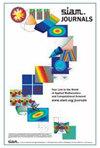Calculation of Epidemic First Passage and Peak Time Probability Distributions
IF 1.9
3区 工程技术
Q2 MATHEMATICS, INTERDISCIPLINARY APPLICATIONS
引用次数: 0
Abstract
SIAM/ASA Journal on Uncertainty Quantification, Volume 12, Issue 2, Page 242-261, June 2024.Abstract. Understanding the timing of the peak of a disease outbreak forms an important part of epidemic forecasting. In many cases, such information is essential for planning increased hospital bed demand and for designing of public health interventions. The time taken for an outbreak to become large is inherently stochastic and, therefore, uncertain, but after a sufficient number of infections has been reached the subsequent dynamics can be modeled accurately using ordinary differential equations. Here, we present analytical and numerical methods for approximating the time at which a stochastic model of a disease outbreak reaches a large number of cases and for quantifying the uncertainty arising from demographic stochasticity around that time. We then project this uncertainty forwards in time using an ordinary differential equation model in order to obtain a distribution for the peak timing of the epidemic that agrees closely with large simulations but that, for error tolerances relevant to most realistic applications, requires a fraction of the computational cost of full Monte Carlo approaches.
流行病首次传播和高峰时间概率分布的计算
SIAM/ASA 不确定性量化期刊》第 12 卷第 2 期第 242-261 页,2024 年 6 月。 摘要了解疾病爆发高峰期的时间是流行病预测的重要组成部分。在许多情况下,这些信息对于规划增加的医院床位需求和设计公共卫生干预措施至关重要。疫情大规模爆发所需的时间本身是随机的,因此也是不确定的,但在达到足够的感染人数后,就可以使用常微分方程对随后的动态进行精确建模。在此,我们提出了分析和数值方法,用于近似计算疾病爆发的随机模型达到大量病例的时间,并量化该时间前后人口随机性带来的不确定性。然后,我们使用常微分方程模型将这种不确定性向前推算,以获得与大型模拟结果密切吻合的流行病高峰时间分布,但对于与大多数现实应用相关的误差容限,所需的计算成本仅为蒙特卡罗方法的一小部分。
本文章由计算机程序翻译,如有差异,请以英文原文为准。
求助全文
约1分钟内获得全文
求助全文
来源期刊

Siam-Asa Journal on Uncertainty Quantification
Mathematics-Statistics and Probability
CiteScore
3.70
自引率
0.00%
发文量
51
期刊介绍:
SIAM/ASA Journal on Uncertainty Quantification (JUQ) publishes research articles presenting significant mathematical, statistical, algorithmic, and application advances in uncertainty quantification, defined as the interface of complex modeling of processes and data, especially characterizations of the uncertainties inherent in the use of such models. The journal also focuses on related fields such as sensitivity analysis, model validation, model calibration, data assimilation, and code verification. The journal also solicits papers describing new ideas that could lead to significant progress in methodology for uncertainty quantification as well as review articles on particular aspects. The journal is dedicated to nurturing synergistic interactions between the mathematical, statistical, computational, and applications communities involved in uncertainty quantification and related areas. JUQ is jointly offered by SIAM and the American Statistical Association.
 求助内容:
求助内容: 应助结果提醒方式:
应助结果提醒方式:


